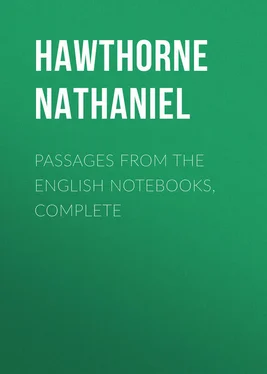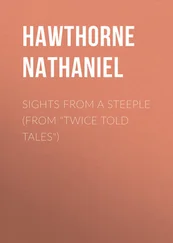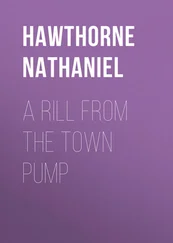Nathaniel Hawthorne - Passages from the English Notebooks, Complete
Здесь есть возможность читать онлайн «Nathaniel Hawthorne - Passages from the English Notebooks, Complete» — ознакомительный отрывок электронной книги совершенно бесплатно, а после прочтения отрывка купить полную версию. В некоторых случаях можно слушать аудио, скачать через торрент в формате fb2 и присутствует краткое содержание. Жанр: История, literature_19, foreign_antique, foreign_prose, Путешествия и география, на английском языке. Описание произведения, (предисловие) а так же отзывы посетителей доступны на портале библиотеки ЛибКат.
- Название:Passages from the English Notebooks, Complete
- Автор:
- Жанр:
- Год:неизвестен
- ISBN:нет данных
- Рейтинг книги:4 / 5. Голосов: 1
-
Избранное:Добавить в избранное
- Отзывы:
-
Ваша оценка:
- 80
- 1
- 2
- 3
- 4
- 5
Passages from the English Notebooks, Complete: краткое содержание, описание и аннотация
Предлагаем к чтению аннотацию, описание, краткое содержание или предисловие (зависит от того, что написал сам автор книги «Passages from the English Notebooks, Complete»). Если вы не нашли необходимую информацию о книге — напишите в комментариях, мы постараемся отыскать её.
Passages from the English Notebooks, Complete — читать онлайн ознакомительный отрывок
Ниже представлен текст книги, разбитый по страницам. Система сохранения места последней прочитанной страницы, позволяет с удобством читать онлайн бесплатно книгу «Passages from the English Notebooks, Complete», без необходимости каждый раз заново искать на чём Вы остановились. Поставьте закладку, и сможете в любой момент перейти на страницу, на которой закончили чтение.
Интервал:
Закладка:
We reached Furness Abbey about twelve. There is a railway station close by the ruins; and a new hotel stands within the precincts of the abbey grounds; and continually there is the shriek, the whiz, the rumble, the bell-ringing, denoting the arrival of the trains; and passengers alight, and step at once (as their choice may be) into the refreshment-room, to get a glass of ale or a cigar, – or upon the gravelled paths of the lawn, leading to the old broken walls and arches of the abbey. The ruins are extensive, and the enclosure of the abbey is stated to have covered a space of sixty-five acres. It is impossible to describe them. The most interesting part is that which was formerly the church, and which, though now roofless, is still surrounded by walls, and retains the remnants of the pillars that formerly supported the intermingling curves of the arches. The floor is all overgrown with grass, strewn with fragments and capitals of pillars. It was a great and stately edifice, the length of the nave and choir having been nearly three hundred feet, and that of the transept more than half as much. The pillars along the nave were alternately a round, solid one and a clustered one. Now, what remains of some of them is even with the ground; others present a stump just high enough to form a seat; and others are, perhaps, a man's height from the ground, – and all are mossy, and with grass and weeds rooted into their chinks, and here and there a tuft of flowers, giving its tender little beauty to their decay. The material of the edifice is a soft red stone, and it is now extensively overgrown with a lichen of a very light gray line, which, at a little distance, makes the walls look as if they had long ago been whitewashed, and now had partially returned to their original color. The arches of the nave and transept were noble and immense; there were four of them together, supporting a tower which has long since disappeared, – arches loftier than I ever conceived to have been made by man. Very possibly, in some cathedral that I have seen, or am yet to see, there may be arches as stately as these; but I doubt whether they can ever show to such advantage in a perfect edifice as they do in this ruin, – most of them broken, only one, as far as I recollect, still completing its sweep. In this state they suggest a greater majesty and beauty than any finished human work can show; the crumbling traces of the half-obliterated design producing somewhat of the effect of the first idea of anything admirable, when it dawns upon the mind of an artist or a poet, – an idea which, do what he may, he is sure to fall short of in his attempt to embody it.
In the middle of the choir is a much-dilapidated monument of a cross-legged knight (a crusader, of course) in armor, very rudely executed; and, against the wall, lie two or three more bruised and battered warriors, with square helmets on their heads and visors down. Nothing can be uglier than these figures; the sculpture of those days seems to have been far behind the architecture. And yet they knew how to put a grotesque expression into the faces of their images, and we saw some fantastic shapes and heads at the lower points of arches which would do to copy into Punch. In the chancel, just at the point below where the high altar stands, was the burial-place of the old Barons of Kendal. The broken crusader, perhaps, represents one of them; and some of their stalwart bones might be found by digging down. Against the wall of the choir, near the vacant space where the altar was, are some stone seats with canopies richly carved in stone, all quite perfectly preserved, where the priests used to sit at intervals, during the celebration of mass. Conceive all these shattered walls, with here and there an arched door, or the great arched vacancy of a window; these broken stones and monuments scattered about; these rows of pillars up and down the nave; these arches, through which a giant might have stepped, and not needed to bow his head, unless in reverence to the sanctity of the place, – conceive it all, with such verdure and embroidery of flowers as the gentle, kindly moisture of the English climate procreates on all old things, making them more beautiful than new, – conceive it with the grass for sole pavement of the long and spacious aisle, and the sky above for the only roof. The sky, to be sure, is more majestic than the tallest of those arches; and yet these latter, perhaps, make the stronger impression of sublimity, because they translate the sweep of the sky to our finite comprehension. It was a most beautiful, warm, sunny day, and the ruins had all the pictorial advantage of bright light and deep shadows. I must not forget that birds flew in and out among the recesses, and chirped and warbled, and made themselves at home there. Doubtless, the birds of the present generation are the posterity of those who first settled in the ruins, after the Reformation; and perhaps the old monks of a still earlier day may have watched them building about the abbey, before it was a ruin at all.
We had an old description of the place with us, aided by which we traced out the principal part of the edifice, such as the church, as already mentioned, and, contiguous to this, the Chapter-house, which is better preserved than the church; also the kitchen, and the room where the monks met to talk; and the range of wall, where their cells probably were. I never before had given myself the trouble to form any distinct idea of what an abbey or monastery was, – a place where holy rites were daily and continually to be performed, with places to eat and sleep contiguous and convenient, in order that the monks might always be at hand to perform those rites. They lived only to worship, and therefore lived under the same roof with their place of worship, which, of course, was the principal object in the edifice, and hallowed the whole of it. We found, too, at one end of the ruins, what is supposed to have been a school-house for the children of the tenantry or villeins of the abbey. All round this room is a bench of stone against the wall, and the pedestal also of the master's seat. There are, likewise, the ruins of the mill; and the mill-stream, which is just as new as ever it was, still goes murmuring and babbling, and passes under two or three old bridges, consisting of a low gray arch overgrown with grass and shrubbery. That stream was the most fleeting and vanishing thing about the ponderous and high-piled abbey; and yet it has outlasted everything else, and might still outlast another such edifice, and be none the worse for wear.
There is not a great deal of ivy upon the walls, and though an ivied wall is a beautiful object, yet it is better not to have too much, – else it is but one wall of unbroken verdure, on which you can see none of the sculptural ornaments, nor any of the hieroglyphics of Time. A sweep of ivy here and there, with the gray wall everywhere showing through, makes the better picture; and I think that nothing is so effective as the little bunches of flowers, a mere handful, that grow in spots where the seeds have been carried by the wind ages ago.
I have made a miserable botch of this description; it is no description, but merely an attempt to preserve something of the impression it made on me, and in this I do not seem to have succeeded at all. I liked the contrast between the sombreness of the old walls, and the sunshine falling through them, and gladdening the grass that floored the aisles; also, I liked the effect of so many idle and cheerful people, strolling into the haunts of the dead monks, and going babbling about, and peering into the dark nooks; and listening to catch some idea of what the building was from a clerical-looking personage, who was explaining it to a party of his friends. I don't know how well acquainted this gentleman might be with the subject; but he seemed anxious not to impart his knowledge too extensively, and gave a pretty direct rebuff to an honest man who ventured an inquiry of him. I think that the railway, and the hotel within the abbey grounds, add to the charm of the place. A moonlight solitary visit might be very good, too, in its way; but I believe that one great charm and beauty of antiquity is, that we view it out of the midst of quite another mode of life; and the more perfectly this can be done, the better. It can never be done more perfectly than at Furness Abbey, which is in itself a very sombre scene, and stands, moreover, in the midst of a melancholy valley, the Saxon name of which means the Vale of the Deadly Nightshade.
Читать дальшеИнтервал:
Закладка:
Похожие книги на «Passages from the English Notebooks, Complete»
Представляем Вашему вниманию похожие книги на «Passages from the English Notebooks, Complete» списком для выбора. Мы отобрали схожую по названию и смыслу литературу в надежде предоставить читателям больше вариантов отыскать новые, интересные, ещё непрочитанные произведения.
Обсуждение, отзывы о книге «Passages from the English Notebooks, Complete» и просто собственные мнения читателей. Оставьте ваши комментарии, напишите, что Вы думаете о произведении, его смысле или главных героях. Укажите что конкретно понравилось, а что нет, и почему Вы так считаете.












